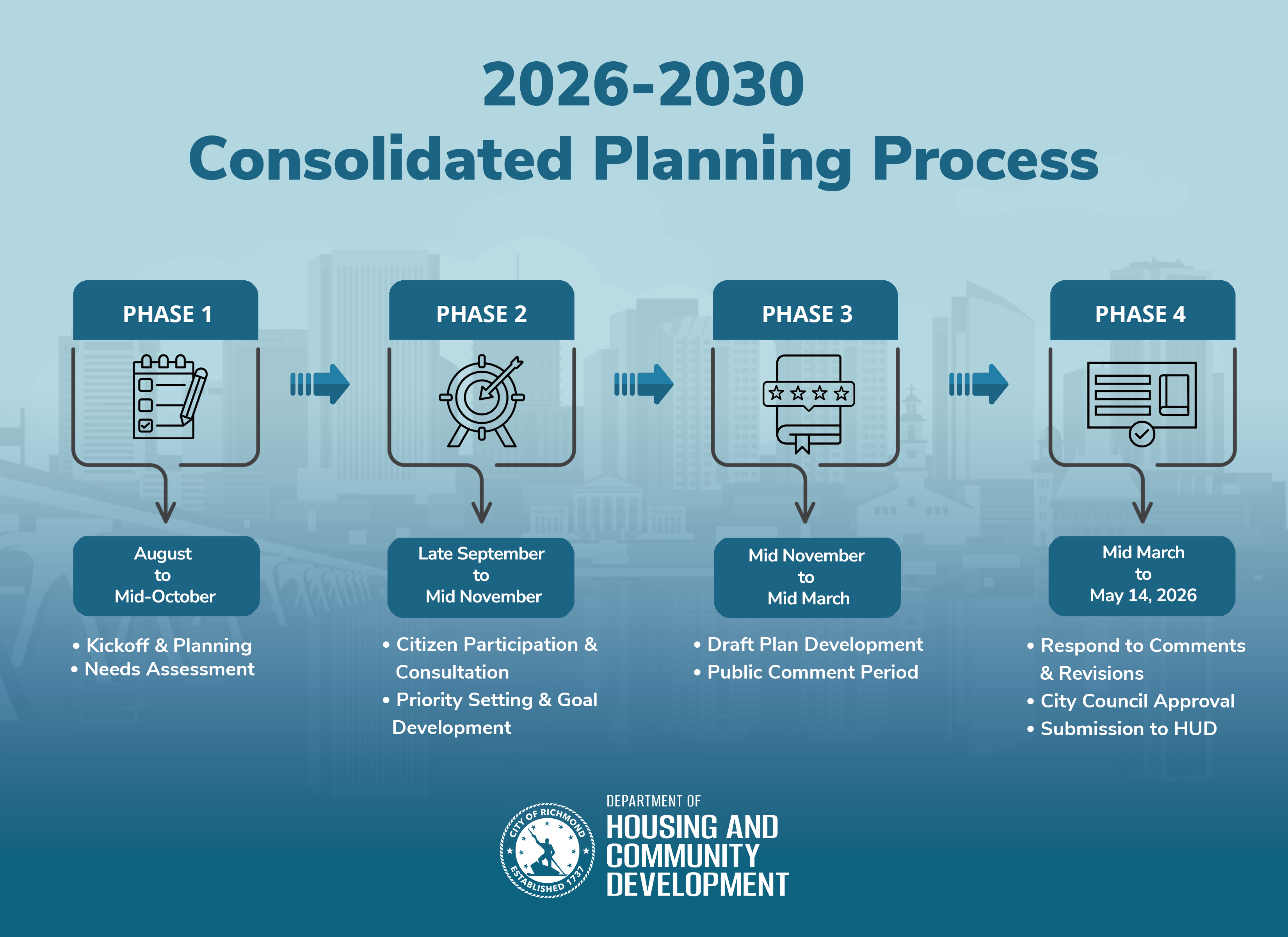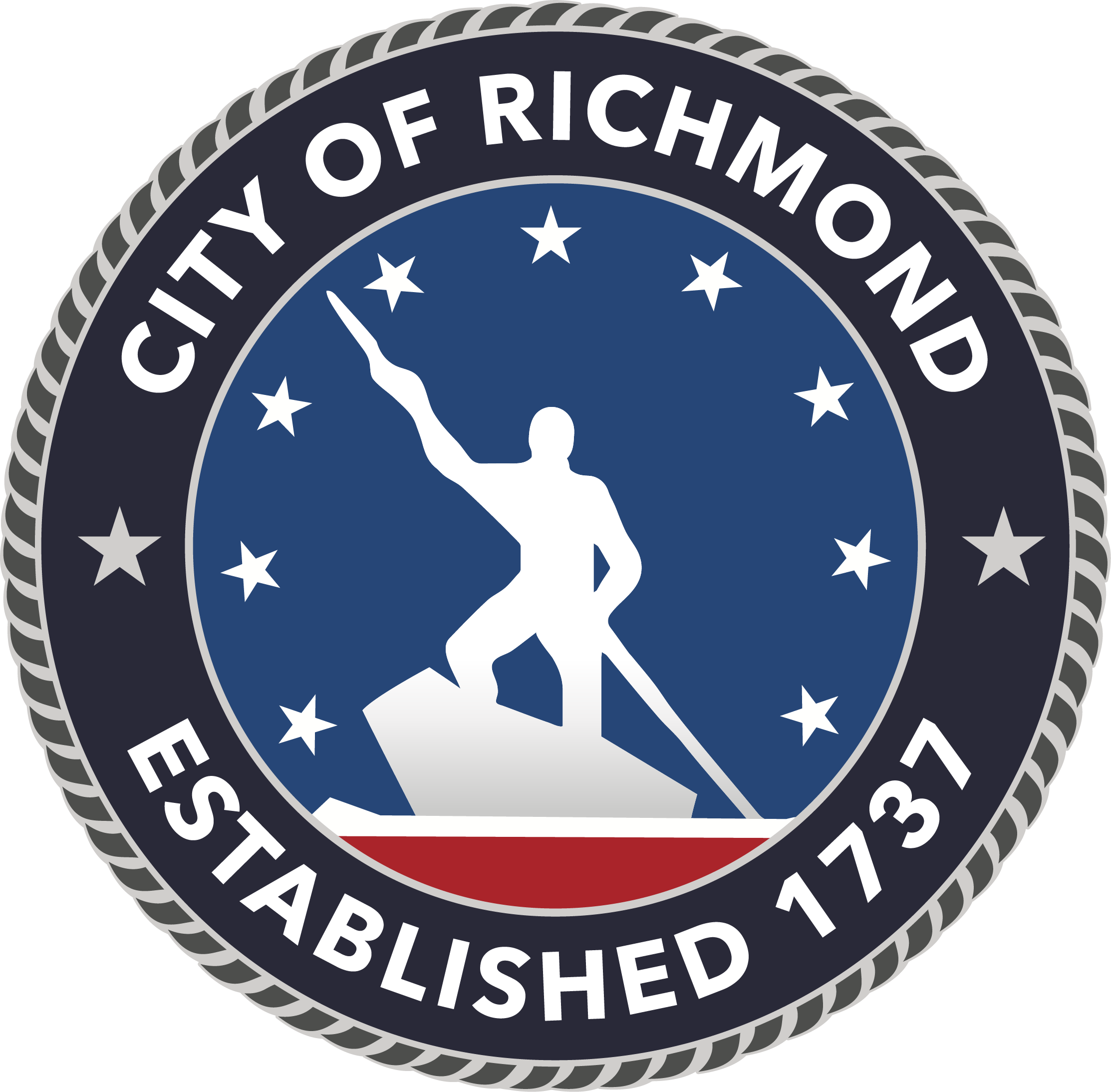City of Richmond
Housing & Community Development
Main Street Station
1500 East Main Street, Suite 300
Richmond, VA 23219
Federally Funded Programs
The City of Richmond invests in homeless prevention and shelter, affordable housing, and neighborhood revitalization through specific federally funded programs including:
- The Community Block Grant program (CDBG).
- The Home Investment Partnership Program (HOME).
- Housing Opportunities for Persons with AIDS (HOPWA); and
- The Emergency Solutions Grant program (ESG).
- The city also implements the federal requirements of Section 3 Employment and Davis Bacon wage rates with the use of federal resources.
U.S. Department of Housing and Urban Development


*Please refer to the Public Docs section of this webpage for the City's Consolidated Plan, Annuals Plans, and other public documents related to federally funded programs
2026-2030 Consolidated Plan
What's a Consolidated Plan?
The Consolidated Plan, or ConPlan, is a five-year plan (2026 - 2030) that jurisdictions must produce to receive federal funding from the Department of Housing and Urban Development (HUD). The plan is intended to align and focus this funding to the City's unmet housing and community development needs. Jurisdictions which receive funding are also required to submit action plans and performance reports on an annual basis. The reports track how the city is progressing towards the goals outlined in the consolidated plan.
You can see Richmond's previous Consolidated Plan (2021-2025) here.
How is this different from the Annual Action Plan?
While the Consolidated Plan provides high level insights into the general direction and objectives for the City's use of federal funding, the Annual Action Plan (AAP) offers more detailed information on funding. The AAP is submitted to HUD on an annual basis, while the ConPlan will occur every five years.
How can I get involved?
Share your thoughts! Between now and early 2026, City staff are working to educate the community about the 2026-2030 ConPlan process and solicit community feedback on the City's housing and community development priorities. The best way to get involved is to attend a public meeting or outreach event, listed below. Alternatively, you can can share your thoughts using our virtual feedback forms:
- For English, click here.
- Para español, haga clic aquí
You can stay up to date by monitoring the City's social media accounts and public notices in local newspapers. You can also provide HCD with your comments at any time by sending an email to hcd@rva.gov.
Public Hearings/Community Meetings
- RVA Builds: September 23, 2025 | Main Street Station | 5-8:30pm
- Public Meeting: November 10th, 2025 | North Ave. Library | 6pm
- Public Meeting: November 13th, 2025 | East End Library | 6pm
- Public Meeting: November 18th, 2025 | Broad Rock Library | 6pm
- Public Meeting: November 19th, 2025 | Randolph Community Center | 6pm
Please stay tuned for additional public engagement sessions where you can share your thoughts and feedback on the Consolidated Plan!
What entitlement funds does the City of Richmond receive?
Each year, the City of Richmond receives roughly $9M in HUD funding through four programs:
- Community Development Block Grant (CDBG)
- HOME Investment Partnerships (HOME
- Housing Opportunities for Persons with AIDS (HOPWA)
- Emergency Solutions Grant (ESG).
All grant funds must be deployed to meet one of HUD's three national objectives: serving low to moderate-income households, eliminating slums and blight, and responding to urgent needs.
What does the City fund with entitlement funds?
The City has historically funded a wide range of public and private entities that are providing social services, making critical home repairs for low-income homeowners, constructing new affordable housing, supporting small businesses and job retention, and providing qualifying individuals with first-time homebuyer education and down payment assistance.
Funded projects are determined through a competitive application process, and the City solicits public input and feedback on recommended projects through its public hearing process and citizen participation plan.
Consolidated Plan Process

Community Development Block Grant Program (CDBG)
The City of Richmond Community Development Block (CDBG) Program receives federal funding to develop viable urban communities by providing decent and affordable housing, services to the most vulnerable individuals in our communities, and by creating jobs through the expansion and retention of businesses, principally for low- and moderate-income persons. One of our primary focuses is to increase the number of affordable housing units for low and moderate income residents.
The CDBG program is one of the longest continuously U.S. Department of Housing and Urban Development (HUD) run programs. Beginning in 1974, the program addresses a wide range of unique community development needs.
The City received $4,462,031 in CDBG Program funding for FY20.
Community Development Block Grant funds constitute the largest block of financial resources available to the City for housing and community development activities. These flexible funds are provided on an annual basis to the City to carry out a wide range of community activities focused in the areas of:
- Housing and Neighborhood Revitalization
- Economic Development
- Public Facilities
- Planning
- Public Services
All CDBG activities must meet a Broad National Objective (BNO). The objectives fall into three primary categories:
- Providing a Benefit to Low to Moderate Income Persons
- Preventing or Eliminating Slums and Blight
- Meeting an urgent need, in cases of natural disasters or other emergencies
CDBG Program funds may be used for activities which include, but are not limited to:
- Acquisition of real property
- Relocation and demolition
- Rehabilitation of residential and non-residential structures Construction of public facilities and improvements, such as water and sewer facilities, streets, neighborhood centers, and the conversion of school buildings for eligible purposes
- Public services, within certain limits
- Activities relating to energy conservation and renewable energy resources
- Provision of assistance to profit-motivated businesses to carry out economic development and job creation/retention activities
To view a list of CDBG Partners, click here.
For a HUD Fact Sheet on the CDBG Program, click here.
Additional information regarding the CDBG Program can be found at https://www.hud.gov.
For questions or information about our CDBG Program please email Housing and Community Development, Deputy Director, Michelle Peters at Michelle.peters@rva.gov.
Home Investment Partnership (HOME) Program
The HOME Program was created by the U.S. Department of Housing and Urban Development (HUD) as part of the National Affordable Housing Act of 1990.
The City of Richmond HOME Investment Partnerships Program (HOME) receives federal funding for neighborhood revitalization programs such as Neighborhoods in Bloom (NiB) and other housing related activities across the City. The City of Richmond uses HOME resources to contract with local housing community development corporations, for-profit organizations, non-profit agencies, and the Richmond Redevelopment and Housing Authority (RRHA) to achieve the ultimate goal of stabilizing and revitalizing affordable housing in targeted City neighborhoods.
The City received $1,455,440 in HOME Program funding for FY20.
For more detailed information regarding the HOME Program, please refer to https://www.hud.gov.
The intent of the Federal HOME Program for localities is to:
- Provide decent affordable housing to low- and moderate-income households;
- Expand the capacity of non-profit housing providers to develop housing; and
- Leverage public- and private-sector resources.
HOME-funded activities [24 CFR 92.252, 92.254] include:
- Homeowner rehabilitation: HOME funds may be used to assist existing owner-occupants with the repair, rehabilitation, or reconstruction of their homes.
- Homebuyer activities: The City of Richmond may finance the acquisition and/or rehabilitation or new construction of homes for homebuyers.
- Rental housing: Affordable rental housing may be acquired and/or rehabilitated, or constructed to increase affordable housing opportunities.
The HOME Program provides grants and low-interest loans to assist low- and moderate-income communities - often in partnership with local nonprofit groups - to fund a wide range of activities described above. It is the largest Federal block grant to state and local governments designed exclusively to create affordable housing for low- and moderate-income households.
Currently, the HOME Program in the City of Richmond provides funding for construction of low-income rental housing, new construction for homeownership, down payment assistance and housing rehabilitation projects:
- Project:HOMES, 804-233-2827, https://www.projecthomes.org/
- Better Housing Coalition (BHC), 804-644-0546, https://www.betterhousingcoalition.org/
- Housing Opportunities Made Equal of VA., (HOME, Inc.),804-354-0641 http://homeofva.org
- Southside Community Development and Housing Corporation (SCDHC), 804-231-4449. https://www.scdhc.com/
- Richmond Metropolitan Habitat for Humanity (RMHFH), 804-232-7001. https://www.richmondhabitat.org/
- Richmond Redevelopment and Housing Authority (RRHA), 804-780-4200. https://www.rrha.com/
Credit Counseling Services
Is your credit not the best? Are you concerned that you may not be able to qualify for a loan because of your credit history or credit problems? Contact the following organizations
- Neighborhood Housing Services of Richmond, Inc.,
- 2712 Chamberlayne Ave, Richmond, VA 23222
- Richmond Housing Opportunities Made Equal (HOME), 804-354-0641, http://homeofva.org/
They can work with you on an individual counseling basis to get your credit back on track and help you get yourself ready for home ownership.
Down Payment Assistance
The HOME program also funds HOME, Inc. for down payment and closing costs assistance to low-income first-time home buyers. HOME, Inc. offers forgivable loans of up to $15,000 for down payment and closing cost assistance to qualified applicants.
Contact HOME to see if you qualify at 804-354-0641. http://homeofva.org/
Home Buyer Education Classes
Classes for first-time and experienced home buyers are available on a regular basis from the following organizations.
- Neighborhood Housing Services of Richmond, Inc.
- Housing Opportunities Made Equal of VA., (HOME, Inc.), 804-354-0641, http://homeofva.org/
- Richmond Virginia Housing Development Authority (VHDA), 804-227-8432, http://www.vhda.com/Pages/Home.aspx
Housing Opportunities for Persons with AIDS (HOPWA)
The City Of Richmond administers the Housing Opportunities for Persons with AIDS (HOPWA) program. The HOPWA Program is designed to help provide needed housing and supportive services for persons living with HIV/AIDS related diseases. Since Richmond is the largest entitlement community in the Metropolitan Statistical Area (MSA), the City of Richmond is required by HUD to administer the funds for the entire MSA, which includes 17 independent jurisdictions; Cities of Richmond, Colonial Heights, Hopewell, Petersburg and the Counties of Amelia, Caroline, Charles City, Chesterfield, Dinwiddie, Goochland, Hanover, Henrico, King William, New Kent, Powhatan, Prince George and Sussex.
The City received $1,186,209 in HOPWA Program funding for FY20.
The City of Richmond contracts with three local non-profits to delivers housing and supportive services programs throughout the MSA.
- Commonwealth Catholic Charities (CCC) provides Case Management, Tenant Based Rental Assistance (TBRA), Short Term Mortgage, Rent & Utility (STRMU) assistance, Permanent Housing Placement assistance such as first month's rent and security deposits. To contact CCC for HOPWA assistance please call 804-529-2004 or visit www.CCCofVA.org
- Serenity Inc. provides Case Management, Short Term Mortgage, Rent & Utility (STRMU) assistance and Permanent Housing Placement assistance such as first month's rent and security deposits. To contact Serenity Inc. for HOPWA assistance please call 804-861-9977 or visit www.serenity-crater.org.
- Virginia Supportive Housing provides Case Management and Housing to residents that live in housing developments owned and operated by VSH that are located in the Richmond area. To contact Virginia Supportive Housing for HOPWA assistance please call 804-232-0481 or visit http://www.virginiasupportivehousing.org.
- Citizens can also call the regional Housing Crisis Line at 804-972-0813. The Housing Crisis Line facilitates access to resources and shelter alternatives for those who are three days or less away from losing their housing. This line is also available for those already experiencing homelessness.
- The best way to find programs and resources available in your community is to contact Virginia 2-1-1. Visit www.211virginia.org/consumer/index.php to find service information online, or call 211 toll-free from anywhere in the state. Get the Street Sheet (English) for a quick reference to services in the Richmond area.
- If you live outside of the Richmond MSA area and need HOPWA assistance please go to the Virginia Department of Housing and Community Development website www.dhcd.virginia.gov or contact Nichele Carver at hsnh@dhcd.virginia.gov.
For questions or additional information about the City's HOPWA Program please contact Housing and Community Development, Senior Project Development Manager, Amanda Wrinkle at Amanda.Wrinkle@rva.gov
Emergency Solutions Grant (ESG)
The Emergency Solutions Grant is a federal resource, allocated by the U.S. Department of Housing and Urban Development, which supports a variety of activities to address homelessness under the Homeless Emergency Assistance and Rapid Transit to Housing (HEARTH) Act of 2009. As an entitlement community, the City of Richmond, receives a direct, annual allocation from HUD. The City uses ESG funds to support homeless shelter operations, rapid re-housing programs, homeless outreach, data management, and program administration.
The City received $376,954 in ESG Program funding for FY20.
In 2019-2020, the City of Richmond has contracts with five local non-profits to deliver rapid re-housing services, emergency shelter, homeless prevention services, database management, and case management.
- Housing Families First provides case management and rapid re-housing services.http://www.housingfamiliesfirst.org/
- CARITAS provides case management and emergency shelter services. https://www.caritasva.org/
- Homeward provides database management and homeless prevention services through the homeless crisis line. 804-972-0813 www.homewardva.org
- YWCA provides case management and rapid re-housing services. www.ywcarichmond.org
- HomeAgain provides case management, rapid re-housing, and emergency shelter services. https://www.homeagainrichmond.org/
For questions or additional information about the City's ESG Program please contact Housing and Community Development, Senior Project Development Manager, Amanda Wrinkle at Amanda.Wrinkle@rva.gov
If you are homeless or at risk of becoming homeless, please call the Homeless Crisis Line at 804-972-0813.
Click here for a HUD Fact Sheet on the ESG Program.
Additional information regarding the ESG Program can be found at https://www.hud.gov.
Section 3
Section 3 is a provision of the Housing and Urban Development Act of 1968. The purpose of Section 3 is to ensure that employment and other economic opportunities generated by certain HUD financial assistance shall, to the greatest extent feasible, and consistent with existing Federal, State, and local laws and regulations, be directed to low- and very low-income persons, particularly those who are recipients of government assistance for housing, and to business concerns which provide economic opportunities to low- and very low-income persons.
For questions regarding Section 3, contact Kristen Stell at Kristen.stell@RVA.GOV
-
What is Section 3, click here.
-
To learn more about Section 3 resources and upcoming trainings, click here.
Davis Bacon Labor Standard
All laborers and mechanics employed by contractors or subcontractors on construction work financed in whole or in part with assistance received under CDBG, ESG, HOME, or HOPWA shall be paid wages at rates not less than those prevailing on similar construction in the locality as determined by the Secretary of Labor in accordance with the Davis-Bacon Act, as amended (40 U.S.C. 276a - 276a-5). By reason of the foregoing requirement, the Contract Work Hours and Safety Standards Act (40 U.S.C. 327 et. seq.) also applies. These requirements apply to all public facility projects and the rehabilitation of residential property only if such property contains more than 8 units. For HOME projects only, this requirement applies to residential properties containing 12 or more units in new construction or rehabilitation activities.
For questions regarding Davis-Bacon, contact Kristen Stell at Kristen.stell@RVA.GOV
- Davis-Bacon Compliance Packet, click here.
- Davis-Bacon and Labor Standards Quick Links and Resources, click here.
- Introduction to Federal Labor Standards Power Point, click here.
Federal and State Historic Tax Credits
State and Federal Historic Tax Credits
The Commonwealth of Virginia offers a 25% investment tax credit to qualified rehabilitation work done to historic properties or properties that contribute to the character of a recognized historic district. This tax credit is available to both owner-occupied houses and income-producing (rental) properties.
The investment tax credit available from the federal government is 20% of qualified rehabilitation expenses. This can be used in combination with the 25% state investment tax credit. The federal tax credit is only available to income-producing (rental) property.
For more information about the historic tax credits, contact the Virginia Department of Historic Resources.







